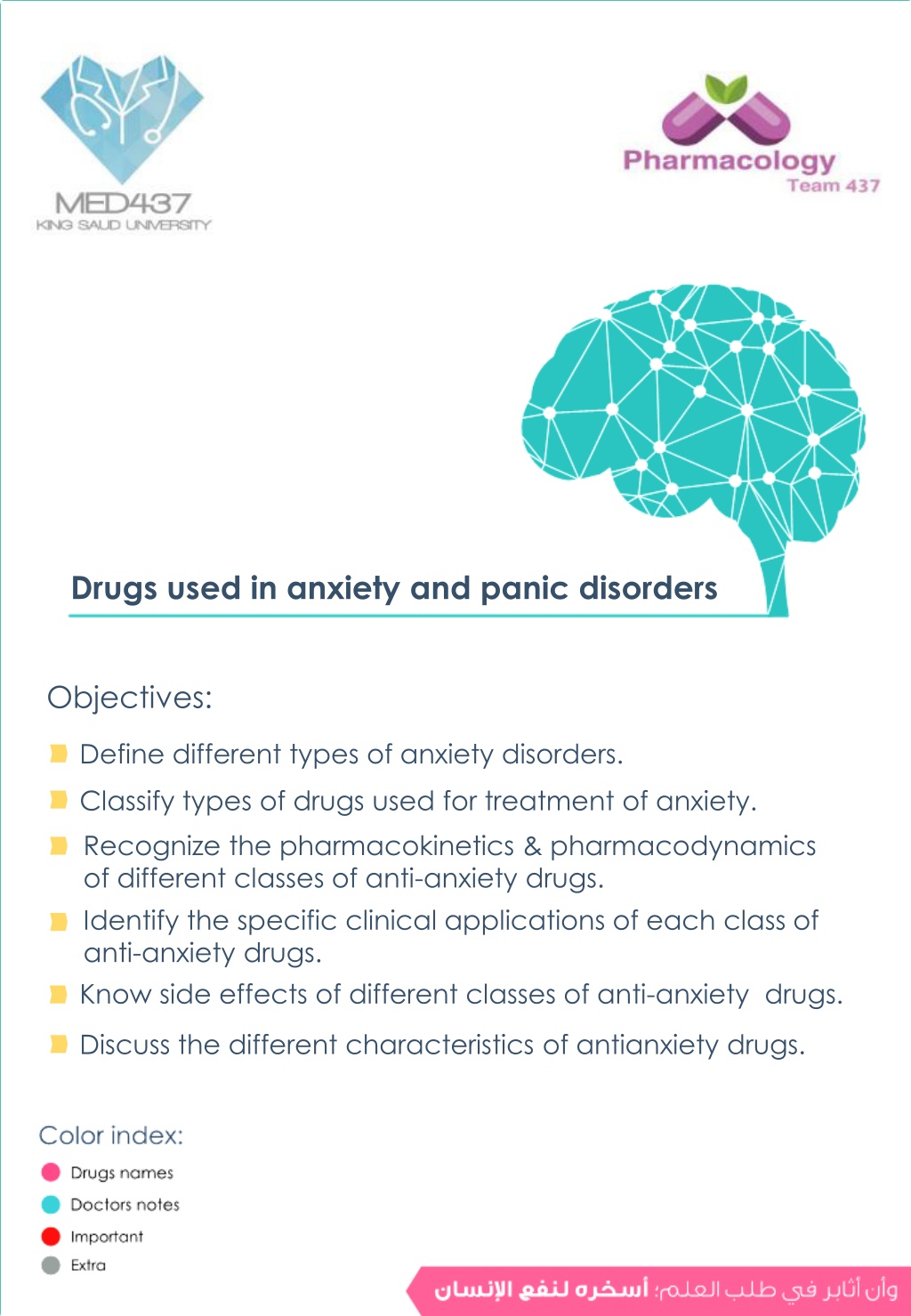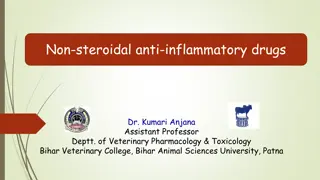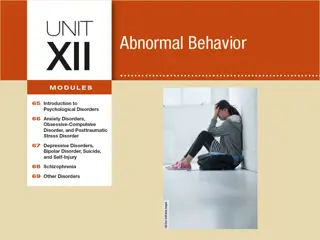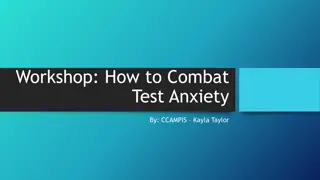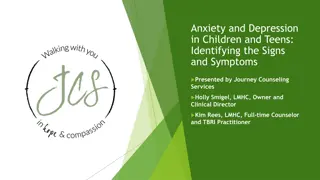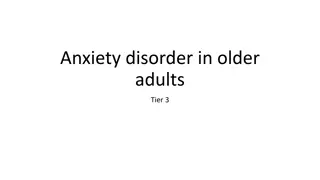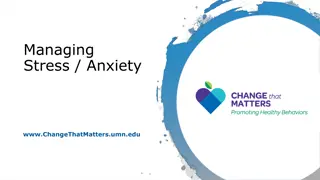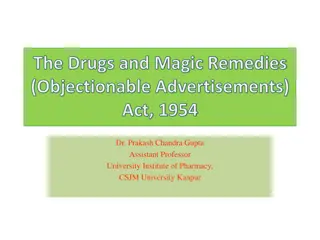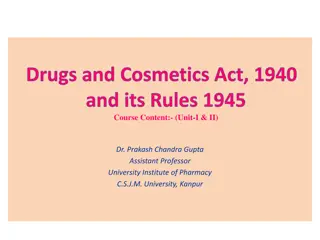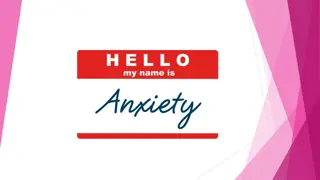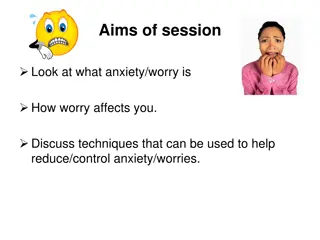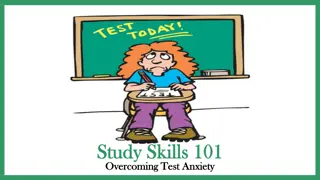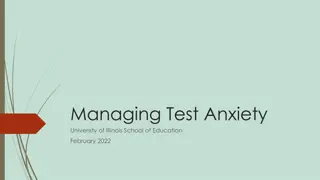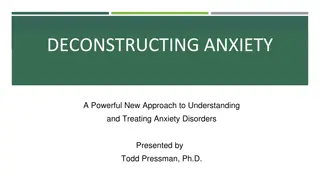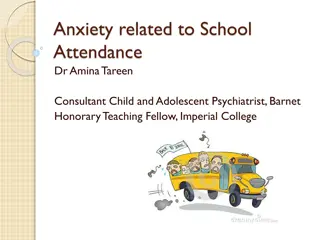Anti-Anxiety Drugs: Types and Uses
Anxiety disorders can be debilitating, but understanding the different types of anti-anxiety drugs, like benzodiazepines, and their pharmacokinetics can help treat symptoms effectively. Explore the classifications, pharmacodynamics, clinical applications, and side effects of these medications.
Download Presentation

Please find below an Image/Link to download the presentation.
The content on the website is provided AS IS for your information and personal use only. It may not be sold, licensed, or shared on other websites without obtaining consent from the author.If you encounter any issues during the download, it is possible that the publisher has removed the file from their server.
You are allowed to download the files provided on this website for personal or commercial use, subject to the condition that they are used lawfully. All files are the property of their respective owners.
The content on the website is provided AS IS for your information and personal use only. It may not be sold, licensed, or shared on other websites without obtaining consent from the author.
E N D
Presentation Transcript
Drugs used in anxiety and panic disorders Objectives: Define different types of anxiety disorders. Classify types of drugs used for treatment of anxiety. Recognize the pharmacokinetics & pharmacodynamics of different classes of anti-anxiety drugs. Identify the specific clinical applications of each class of anti-anxiety drugs. Know side effects of different classes of anti-anxiety drugs. Discuss the different characteristics of antianxiety drugs.
Introduction Anxiety Physical and emotional distress which interferes with normal life. Physical or somatic symptoms Emotional or psychological symptom Sympathetic symptoms: - Sweating - Tachycardia - Shortness of breath - Stomach upset - Frequent urination or diarrhea - Sleep disturbances (Insomnia) - Fatigue - Feeling tense - Trouble concentrating -Irrational (without reason) and excessive fear and worry - Irritability -Restlessness Types of anxiety Post-traumatic stress disorder (PTSD) Generalized anxiety disorder (GAD) An anxiety disorder that affects people who have experienced a severe emotional trauma, such as rape or dramatic car accident, or even war. Patients are usually and constantly worried about everything, health, money, work with no apparent reason. Obsessive-compulsive disorder (OCD) Phobias An intense, uncontrolled fear of a specific situation such as open spaces & heights An anxiety disorder in which people cannot prevent themselves from unwanted thoughts or behaviors that seem impossible to stop e.g. washing their hands Panic disorder Sudden, intense and acute attacks of anxiety in certain situations. Panic attacks cannot be predicted. 1
Overview of anxiety treatment 4:05 min Benzodiazepines suffix zolam or zepam MOA 1-binding to BZ receptors in the brain enhance GABA action on the brain GABA ( -aminobutyric acid):is an inhibitory neurotransmitter 2- chloride channels opening chloride influx to the cell 3-hyperpolarization more difficult to depolarize reduction of neural excitability. are lipid soluble , widely distributed. cross placental barrier (Fetal depression). excreted in milk (neonatal depression). well absorbed orally , Chlordiazepoxide- Diazepam(IV only NOT IM) metabolized in the liver to active metabolites (long duration of action- cumulative effect) and excreted in urine. P.K
Benzodiazepines Depression function skeletal muscle relaxing effect (diazepam) by increasing presynaptic inhibition in the spinal cord anticonvulsant effect e.g. clonazepam, diazepam, lorazepam. Therapeutic doses have minimal depressant effects on: cardiovascular & respiratory systems of cognitive and psychomotor CNS depressants: - Anxiolytic action. - Sedation , Hypnotic action. = sleeping pills -Anterograde amnesia. temporary impairment of memory actions Therapeutic uses Anxiety disorders: Short term relief of severe anxiety, General anxiety disorder, OCD, Panic disorder with depression Alprazolam (antidepressant effect) Benzodiazepines are fast acting typically bringing relief within (30mins hour). Sleep disorders (Insomnia): Triazolam, Lorazepam, Flurazepam. They tend to decrease the latency to sleep onset and increase Stage II of NREM sleep. Treatment of epilepsy: Diazepam Lorazepam. In anesthesia: Pre-anesthetic medication (diazepam). Induction of anesthesia (Midazolam, IV) Alcohol withdrawal syndrome: (diazepam) Psychological & physical dependence with continuous use. withdrawal symptoms:(insomnia, anorexia, anxiety, agitation,tremors,convulsion). Respiratory & cardiovascular depression in large doses only (toxic effects). cognitive impairment ataxia (motor incoordination) impairment of driving ability anterograde amnesia hangover:(excess sedation , drowsiness , confusion) tolerance ADRs Precautions Pregnant women or breast-feeding. Dose reduction is recommended in Liver disease & old people Drug-Drug interaction CNS depressants e.g. alcohol & antihistamine (1stgeneration) increase effect of benzodiazepines (Additive effect) Cytochrome P450 inhibitors e.g. cimetidine & erythromycin increase t1/2 of benzodiazepines CYT P450 inducers phenytoin & rifampicin decreased t1/2 of benzodiazepines (all epileptic drugs are inducers) flumazenil M.O.A - Selective, benzodiazepine receptor antagonist. bind compatitivly to GABA recptors replacing BDZ P.K - Injection (IV only) - Short plasma half life so repeated dosing is required. - Benzodiazepines overdose (antidote) - Can precipitate withdrawal symptoms in benzodiazepines addicts
5HT-1A agonist Buspirone M.O.A acts as a partial agonist at 5HT-1A receptors pre-synapticaly inhibiting 5HT release -Adaptive changes after chronic treatment , reduction in 5HT2 receptors in cortex -Weak dopapamineD2 action , but not antipsychotic P.K rapidly absorbed orally slow onset of action (delayed effect) - T1/2 :(2-4)H undergoes extensive hepatic metabolism , it s clearance is reduced by liver dysfunction actions Only anxiolytic No hypnotic effect. No muscle relaxant effect. No anticonvulsant action. No alcohol additive effect. it doesn t impair memory and coordination. -Does not affect driving skills. -Minimal risk of dependence. -No withdrawal symptoms -No potentiation of other CNS depressants -Minimal psychomotor & cognitive dysfunctions 1) 2) 3) 4) 5) 6) indications - As anxiolytic in generalized anxiety disorders. disadvan- tage / ADRs Slow onset of action (delayed effect) GIT upset, dizziness, drowsiness Not effective in severe anxiety/panic disorders Drug interactions with CYT P450 inducers and inhibitors 1) 2) 3) 4) drug - CYP450 3A4 Inhibitors (verapamil, diltiazem) buspirone level - CYP450 3A4 Inducers (Rifampin) 10 folds buspirone level. - MAOIs increase BP. interactions - Pregnant women or breast-feeding. - Old people (>65) - Dose reductionis recommended in liver disease, old precautions selective sertonin reuptake inhiptors (SSRIs) Fluoxetine M.O.A acts by blocking uptake of 5-HT P.K -given orally -long half life uses Considered the first line of treatment for most anxiety disorders (panic disorder, OCD, GAD, PTSD, phobia), because they are well tolerated, have low risk for dependency and abuse and low potential for overdose. ADRs 1- Delayed onset of action (weeks). 2- Nausea, diarrhea GIT upset 3- SSRIs may cause weight gain or loss. 4- Sexual dysfunction 5- Dry mouth 6- Sleep disturbance or insomnia 7- Seizures
tricyclic antideprresant Doxepin - Imipramine - Desipramine M.O.A Act by reducing uptake of 5HT & NA O.O.A Delayed onset of action (weeks). uses 1- Used for anxietyespecially associated with depression 2- Effective for panic attacks. ADRs Atropine like actions (dry mouth-blurred vision, tachycardia, urinary retention). -blocking activity (Postural hypotension). Sexual dysfunction. Weight gain. beta blockers Propranolol atenolol M.O.A Act by blocking peripheral sympathetic system. 1. Reduce somatic symptoms of anxiety. 2. Decrease BP & slow heart rate. 3. uses - Used in performance or social anxiety. - Are less effective for other forms of anxiety. ADRs - Should be used with caution in asthma, cardiac failure, peripheral vascular disorders. because of beta2 effect Monoamine oxidase inhibitors (MAOIs) Phenelzine Acts by blocking the action of MAO enzymes M.O.A Require dietary restriction avoid wine, beer, fermented foods and old cheese that contain tyramine. P.K Used for panic attacks and phobia uses ADRs Dry mouth, constipation, diarrhea, restlessness, dizziness.
summary & Q MCQs 1)Which one of the following drug cause muscle relaxant ? A-Triazolam B-Lorazepam C-Diazepam D-Alprazolam 2)Which one of the following drugs is used in performance and social anxiety? A-lorazepam B-fluoxetine C-imipramine D-propranolol 3)Which one of the following is considered the 1st line of treatment in most anxiety disorders ? A-triazolam B-atenolol C-fluoxetine D-buspirone 4)Which one of the following is used as an antidote to benzodiazepines overdose ? A-flumazenil B-atenolol C-fluoxetine D-buspirone 4-A 3-C 2-D 1-C
Team leaders: Ghaida Saad Alsanad Omar Alsuhaibani Team Members: Mohammed Alswoaiegh Big thanks to Alanoud Almufarrej References: - Doctors slides and notes. - pharmacology Team 435. Special thank for team 435 @Pharma4370 Pharm437@gmail.com
